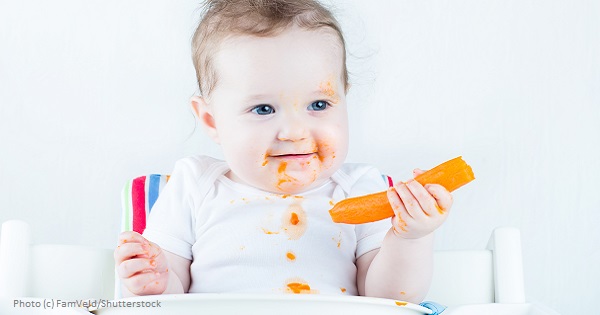 |
The point is to bypass the traditional progression of puréed, mashed, and lumpy foods and move right to solids – along with breastmilk, of course. At six months old, most babies have strong necks and can sit up if they are supported. Their hand-eye coordination has developed to the extent that they can reach out and start to grasp food and grip it in their palms. And that’s when nutritious finger foods become interesting to them. So that’s the key, to my mind: letting baby decide when to wean herself onto solid foods – and, ultimately, off the breast, although many babies will continue breastfeeding in tandem with eating adult food. In fact, breastmilk will continue to be your baby’s main source of nutrition for quite some time still. One of the fun things about baby-led weaning is that your little one will be able to join in with family meals. And, if my experience is any guide, she will be less likely to become a fussy eater later on. She might just play with the food at the beginning, or suck on the pieces, but that’s a good way to get acquainted with food. Begin with foods that are fist-friendly, such as those shaped like a French fry (but not one!) or carrot, or that have a “handle,” like cooked broccoli. This is because small babies have not yet developed a pincer grip and can only clasp foods in their fists. Be prepared for some mess; you might want to put a mat under the highchair so you can relax and not worry about clean-up. Your baby might gag, but as long as he is sitting up, there is little danger of him choking. At any rate, you or another adult should always be present just in case. What Kind of Food? Foods should be the right shape to hold onto, and big enough for clumsy fingers to grasp. Vegetables should be steamed or roasted until soft enough to eat, but not soft enough to fall apart, then cooled. Some fruits, such as melon or mango, may be too slippery at first. Here are some suggestions to begin: • Slices of pear, apple, banana, cucumber, and carrot • Bread sticks, rice cakes, oatcakes, toast fingers • Pieces of cheddar cheese • Breakfast cereals, dried fruit, peas, raisins (once they can pick them up using their thumb and index finger) • Tender pieces of meat You may want to give your baby organic fruits and vegetables to reduce the amount of pesticide residues they consume. Giving your baby gluten before they’re six months old could increase their chance of developing celiac disease. And what about food allergies? If there are allergies in your family, you might want to avoid foods like wheat, dairy, eggs, citrus, nuts, and strawberries. However, you will be reassured to know that research shows that babies who eat more fresh fruits and veggies are less likely to develop food allergies later. (See sidebar.) Even if you don’t suspect a nut allergy, avoid nuts until at least one year of age and until any danger of choking is past. The same for grapes. Avoid salt and sugar. And honey shouldn’t be fed to infants under one year of age. You might want to introduce your baby to one new food at a time, and wait two to three days before starting another food. After each new food, watch for any allergic reactions such as diarrhea, rash, or vomiting. So save yourself the work of puréeing, and trust your little one to experiment with solids on their own. It’s natural, allows the baby to control the speed of the weaning transition, trusts them with a bit of independence, develops their hand-eye coordination, and enables them to explore the many different tastes, textures, weights, and shapes of nourishing food. They can also practice moving food around in their mouth and chewing, which aids in jaw development. And you’ll all enjoy their participation in family meals from a young age, while they continue to benefit from breast milk. I think you’ll be glad that you gave your baby this opportunity to develop naturally in yet another way! Wendy Priesnitz is the editor of Natural Child Magazine, the mother of two adult daughters, and the author of thirteen books.
| |






